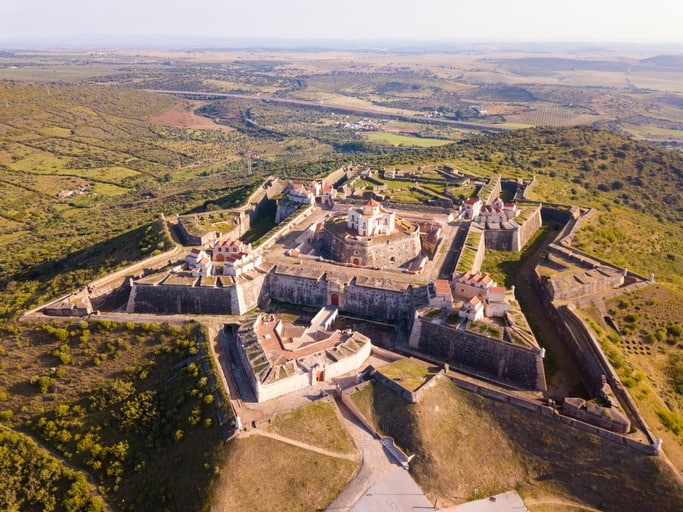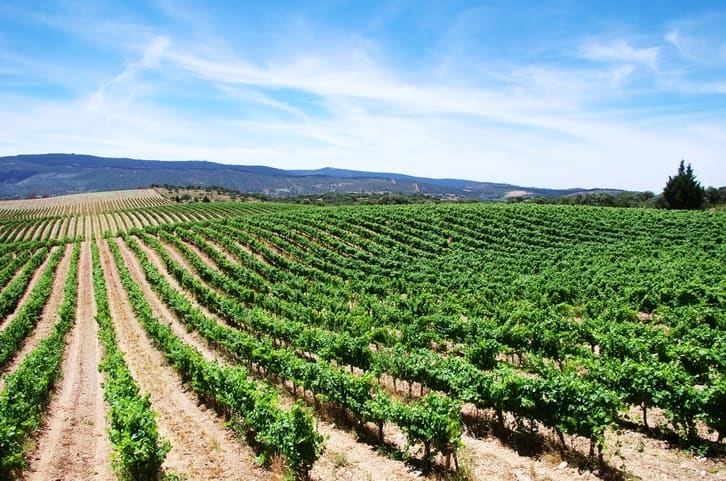Alentejo, Portugal Regional Profile
Last Updated on November 3, 2023.
Take a 90-minute drive south of Lisbon, and you will find yourself in the incredibly dynamic wine region of Alentejo in southern Portugal. This region covers one-third of Portugal and is home to many of the popular red and white blends you’ll find on wine lists in cafes and restaurants around the country.
Alentejo was once part of the Roman province of Lusitania, and is the only wine region in Portugal where winemakers still practice the ancient Roman technique of fermenting and storing wine in clay pots, or amphora. These clay pots, called “talhas de barro,” come in all different sizes, with some holding up to 520 gallons of wine and standing up to seven feet tall. Wines made in these vessels can be labeled “Talha” if they qualify as fully Talha wines.
Winetravelers to this historic and culturally rich region can choose to embark on the Alentejo Wine Route, which includes over 70 member wineries. The route offers visitors different experiences, from simple tastings to more adventurous excursions. Some wineries along the route can also host travelers in guest houses located on their properties.
To learn more about the wine region and taste wines from several different wineries, Winetravelers should visit the Wines of Alentejo tasting room located in the city of Évora.
Alentejo Climate & Terroir
The region of Alentejo is largely a hot and dry land and enjoys 3,000 hours of sunshine annually, which is the highest average amount of time in Portugal. Annual rainfall averages only about 23 inches, compared to 25 inches in Napa Valley, California. Due to climate change, Alentejo has made sustainability a top priority (see WASP program below), including practices such as energy, water, and waste management in the vineyards as well as in the winery.
Most of the region is marked by plains and gently rolling hills. The soils of Alentejo are more varied than anywhere else in Portugal, and much of the soil quality is poor in nutrients, which is perfect for grape vines. The soil types found throughout the area include schist, pink marble, granite, limestone, and a sub-layer of water-retaining clay.
Alentejo is also home to an abundance of wildlife and other important crops, such as olive trees and the famous cork trees of Portugal. It is the wide diversity of this region in both flora and fauna that makes it so unique in its natural beauty.
RELATED: Learn About Wine Regions and Plan Trips Using the Free Winetraveler App
Grape Varieties of Alentejo
Portugal is home to over 250 native grape varieties. Many of these varieties can be found in the Alentejo region, where the warm climate creates the scenario for the best expression of these grapes in the glass.
The most common grapes used in the region of Alentejo include the following:
The Antão Vaz variety, which contributes great aromas and tropical fruit flavors, is one of the dominant grape varieties used in white blends. Other white grapes include Arinto and Roupeiro (Malvasia, Siria), which provide excellent acidity, as well as Verdelho, Diagalves, Manteúdo, Perrum, Rabo de Ovelha, and Fernão Pires.
Red grapes used in blends across the region include Aragonez (Tempranillo), Alicante Bouschet, Touriga Nacional, Alfrocheiro, Castelão, Trincadeira, Moreto, Tinta Grossa, and Tinta Caiada.
RELATED: Portugal Travel Itinerary: 10-12 Days in Porto, Lisbon & Central Portugal
Subregions in Alentejo
The entire PDO of Alentejo is further divided into eight sub-regions. For a wine to be certified as an Alentejo PDO wine, it must come from one of these subregions and follow strict guidelines, such as the inclusion of approved grapes in the wines. Some producers may use these regions on their label, while others choose to label their wines as Vinho Regional Alentejano, noting the larger region. The more general Alentejano designation allows for looser regulations and more freedom in areas such as the use of non-native grapes.
Portalegre is the subregion furthest north and is found northeast of the foothills of the Serra de São Mamede mountains. In this area, there is higher annual rainfall and cooler temperatures at night than in other parts of the region. Additionally, in Portalegre, many vines are planted on steep slopes of up to 2500 feet, and there are segments of older vines, some up to 70 years old, which can create more elegant and complex wines. One of the more unusual predominant red grapes here is Grand Noir, related to Alicante Bouschet, although the region also produces white wines of great quality.
RELATED: Learn About the Arinto Grape Variety & Growing Regions
The regions of Borba, Évora, Redondo, and Reguengos are where some of the more typical, easy-drinking Alentejano wines are made. In Borba, marble bedrock influences the viticulture, and in turn, the characteristics of the wines.
Évora is considered the birthplace of Alentejo’s most sought-after wines. This area reached a peak of production at the end of the 19th century, but faced setbacks with the introduction of phylloxera, followed by the country’s focus on wheat crops in the mid-20th century. However, the wines of Évora have reemerged to great success again since the late 1980s.
Redondo is known for being a hilly area, where there are consistently cold, dry winters and hot, sunny summers.
Reguengos is the largest subregion, with some of the oldest vineyards in the whole Alentejo area. This region is known for its powerful, age-worthy wines.
The Granja-Amareleja subregion is one of the aridest and most inhospitable regions in the country. The area has poor soils and extremely hot summers, which means early ripening of the grapes. The red grape, Moreto, does well here, as it is suited to the harsh climate.
Moura wines are usually softer with high alcohol. The Castelão grape grows well in this continental climate, which includes huge temperature variations. .
Finally, Vidigueira is the southernmost subregion of Alentejo. It has the mildest climate due to cool air from ocean winds, which also contribute to a big diurnal swing in temperatures from day to night. This region is marked by rolling hills and a unique schist soil. Vidigueira is home to the mysterious Tinta Grossa grape.
Wines of Alentejo Sustainability Program (WASP)
In 2015, the CVRA (Comissão Vitivinicola Regional Alentejana) launched a regional sustainability program with the mission to “reduce costs and increase economic viability through a proactive approach to environmental pressures and social concerns.” This is a free-of-charge and voluntary program for producers in the area, and it has seen tremendous growth since its beginnings in 2015. The program started with only 96 members, and as of 2022, includes over 600 members out of 1,800 winegrowers, and 260 wineries. This represents over 12,000 hectares of vineyards included in the program.
The WASP program has become a model for others around the world interested in prioritizing sustainable practices in their vineyards and beyond. The model encompasses more than just producers, but also works with regional and international universities, the Portuguese EPA, and the Portuguese chapter of the Forest Stewardship Council.
The WASP program has been recognized for its contributions to sustainability as one of 15 winners, out of 200 applicants, of the European Commission´s European Rural Innovation Award 2019, and was one of the EU’s Rural Innovation Ambassadors for 2020. In January 2020, WASP earned a national award for Innovation/Investigation from Portugal’s Revista de Vinhos (Review of Wines).
According to the WASP program, a few of their successes include the following:
After just five years of the program, members worked to reduce dependence on pesticides and sprays by planting cover crops and hedgerows to attract insect-eating mammals, and installing nest boxes or perches for insect-eating birds. The initiative has grown to include several times the original number of members participating.
When it comes to water conservation, the WASP program encourages renewable energy and water conservation through free training, largely conducted by WASP’s Sustainability Coordinator João Barroso, an environmental engineer. Over four years, Barroso trained 400 people in this initiative.
A full sustainability program goes beyond the vineyard, especially when considering 80% of the employees of the winery live in the village where it is located. Through the WASP program, there has been a focus on integrating the winery into the community. This includes assisting with school programs or firefighting, donations to charity events, or hosting “open house” days for families to visit the cellar.
The WASP program also encourages its members to obtain a third-party certification for sustainability to advertise their sustainable practices. Members have the option of working with organizations such as SGS, Bureau Veritas, Certis, and Sativa.
These are just a few of the accomplishments of the WASP program over five years in existence. It’s clear that the region of Alentejo and the leadership of the WASP program are continuing to pave the way and create a global model for sustainability in the vineyard and beyond.
Some producers in Alentejo participating in the WASP program include:
Casa Relvas
Herdade de Coelheiros
Herdade do Esporão
Herdade Dos Grous
Reguengos Garrafeira
*Information and statistics courtesy of Wines of Alentejo.
Written By Jacqueline Coleman
Jacqueline Coleman is a professional wine + travel writer, wine judge, columnist, and consultant based in Miami, FL.



[…] growing certain heat-loving grape varietals, as it gets over 3,000 hours of sunlight per year (via Wine Traveler). Wines here are brawny and bold with fully developed flavors and a notch higher alcohol content […]